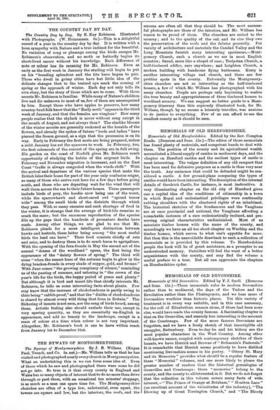The Country Day by Day. By E. Kay Robinson. Illustrated
with Photographs. (W. Heinemann. Gs.)—This is a delightful record of a year in the country day by day. It is written with a keen sympathy with Nature and a true instinct for the beautiful. No variation of song or plumage among the birds escapes Mr. Robinson's observation, and no moth or butterfly begins its short-lived career without his knowledge. Each difference of note or colour has its meaning for Mr. Robinson. Even as early as the first week in January the starling will begin to put on his "breeding splendour and the tits have begun to pair. Those who dwell in grimy cities have but little idea of the delicate changes that to the trained eye mark the coming of spring or the approach of winter. Each day not only tells its own story, but the story of those which are to come. With these secrets Mr. Robinson is familiar. While many of Nature's children live and die unknown to most of us, few of them are unrecognised by him. Except those who have apples to preserve, how many country-bred folk know that the "Early moth" appears in the third week of January, and that the females are wingless ? How many people realise that the skylark is never without song except in the month of August, and not always then ? The starlike blooms of the winter aconite are generally reckoned as the heralds of the flowers, and already the spikes of future "lords and ladies" have pierced the frozen ground, as a sign that the procession is on its way. Early in February the first nests are being prepared, unless a:mild January has set the sparrows to work. In February, too, the first rehearsals of the concert of the spring are in full swing. His garden on the coast of Norfolk gives Mr. Robinson much opportunity of studying the habits of the migrant birds. In February and November migration is incessant, and on the East Coast "traffic is always congested when the winds shift." With the arrival and departure of the various species that make the British Isles their home for part of the year only confusion reigns, as many of those who arrive rost here for a few days before going south, and those who are departing wait for tho wind that will waft them across the sea to their future homes. These passengers include birds of prey, the hoodie crow being one of the worst, while the sparrowhawk and short-oared owl "spread terror wide" among the small birds of the districts through which they pass. With so many enemies and such shortage of food in the winter, it is strange that the average of bird-life remains so much the same ; but the enormous reproduction of the species fills up the gaps that the hundreds of premature deaths have made. Among other things, we are glad to see that Mr. Robinson pleads for a more intelligent distinction between hawks and kestrels, these latter being among "the most useful birds the land can have." Their food consists chiefly of rats and mice, and to destroy them is to do much harm to agriculture. With the opening of the fern-fronds in May the second act of the annual "drama of the woodland" opens, the first being the appearance of the "dainty flowers of spring." The third will come "when the sunset hues of the autumn begin to glow in the dying bracken-fronds in every shade of copper, gold, and bronze." With June comes "the growing conspiracy of silence," reminding us of the passing of summer, and ushering in "the crown of the year's life for the birds, the happy period of peace and plenty." But although it is bird and insect life that chiefly interests Mr. Robinson, he tells us some interesting facts about plants. Few may know that the increase of rhododendrons is partly owing to their being "rabbit-proof," and that the "dislike of rhododendrons is shared by almost every wild thing that lives in Britain." The flickering of insects is not seen, nor the song of birds heard, among them. Artistic feeling also should exclude their use, except in very sparing quantity, as they are essentially un-English in appearance, and add no beauty to the landscape, except in a mass of colour at a time when colour is not very important. Altogether, Mr. Robinson's book is one to have within reach from January 1st to December 31st.


















































 Previous page
Previous page